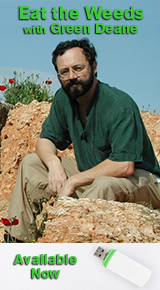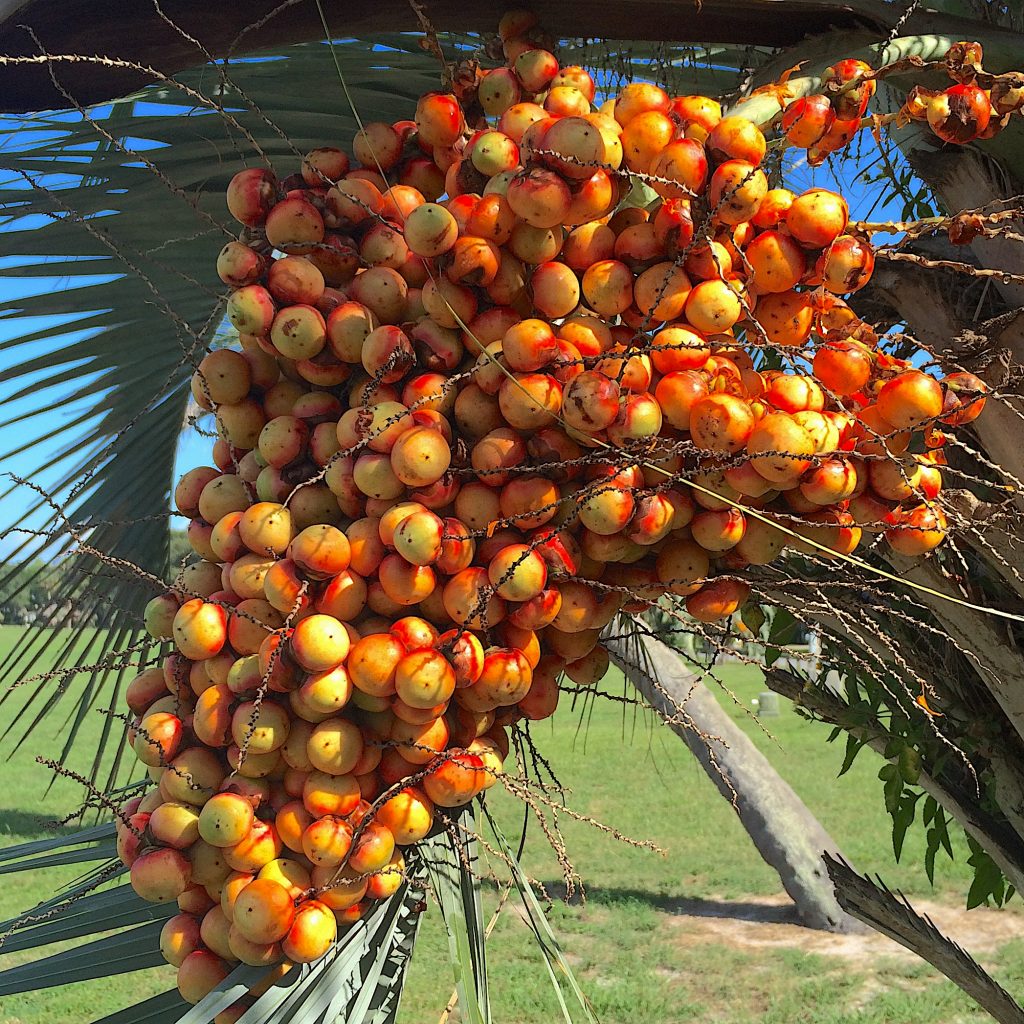
Pindo Palm can fruit almost anytime. Photo by Green Deane
Pindo palm’s season is long, and ripe fruit was spotted recently. The yellow fruit has a banana-mango-ish flavor and the translucent seed inside tastes like coconut. The seed is also far easier to get out of the shell than queen palm fruit, which has a similar flavor. Pindo palm fruit is high in carotinoids and phenolic compounds. It also has lutein, zeaxanthin and fibre. Botanically Butia capitata, the fruit has been made into juices, alcoholic beverages, jams, jellies, ice creams and the seed oil for cooking and soap making. It is also called Jelly palm because in some years the fruit can be made into jelly without having to add pectin or sugar. A century ago its leaves were sun dried, woven, and used in mattresses, chairs, and sofas. Almost all Pindo palm have been cultivated, they don’t tend to escape into the wild, so look for them in yards, landscaping, parks and in particular, cemeteries. Most home owners don’t know the fruit is edible and view them as a messy plant. Ask to clear up the fruit for them, take home and enjoy.
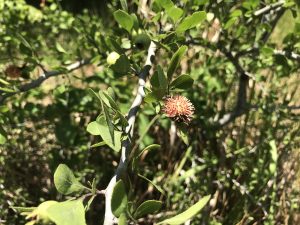
Gall on a Hawthorn. photo by Green Deane
Shall we get technical? Most foragers would look at this picture to the right and say that is a gall. beginners might think it’s a strange fruit . Plant galls are defined as abnormal plant growths caused by a gall-maker; the gall-maker being certain insects, mites, fungi, and bacteria. Locally Persea Borbornia usually has a lot galls — one of the identifying characteristics — and one particular scrub oak gets galls that look like cranberries.This is a gall on a Hawthorn fruit and is a fungus, Gymnosporangium clavipes, which is responsible for the disease known as Cedar-Quince Rust. The “cedar” in the relationship is actually the eastern red cedar, which is really a juniper, Juniperous virginana. This fungus must alternate between junipers and a member of the rose family, such as quince, hawthorn, firethorn, crabapple, etc., to complete its life cycle. It spends a year on plant in the two groups then a year on the other plant.

Classes are held rain or shine (but not during hurricanes.) Photo by Kelly Fagan.
Foraging classes: There is a good chance of rain this weekend, so dress appropriately for the classes.
May 10th, Red Bug Slough 5200 S. Beneva Road, Sarasota. 9 a.m. to noon.
May 11th Wickham Park: 2500 Parkway Drive, Melbourne, FL 32935-2335. Meet at the “dog park” inside the park. 9 a.m. to noon. Bring cash on the day of class or click here to pay for your class. If cost is a hardship email me at: GreenDeane@gmail.com.
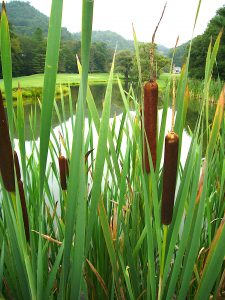
Cattails in North Carolina. Photo by Green Deane
If you were starving and came upon a patch of cattails (blossoming now) you would have great cause for celebration. You have found food and water. You will survive. But if you are not starving and do not have all the time in the inter-connected world you just might find cattails highly overrated. It is true that no plant can produce more starch per acre than cattails, about 3.5 tons under cultivation. And it can produce a lot of starch economically if you can mechanize the extraction. But hand extraction is time- consuming and labor intensive. It is also wet, smelly work all of which can be worsened significantly by harvesting in cold weather. So yes, cattails are food but the time demand is such that harvesting food has to be your prime occupation. A similar argument can be made for kudzu. The roots do have edible starch but it takes a gargantuan amount of work to get the starch out, literally hours of steady pounding. It is not a calorie positive activity. It moves you closer to starvation. But, mechanize the process with some hammers run by falling water — or pounding hammers run by a horse fed on an endless supply of grass — and kudzu becomes a reliable calorie-positive food. You can see my video on cattails here. I also have an article on Finding Caloric Staples with links to relevant videos.
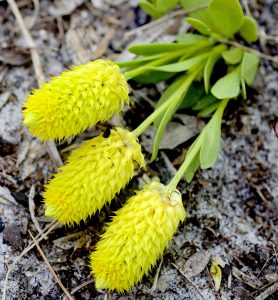
Candyroot and be yellow or orange, tall and short. Photo by Green Deane
In the realm of plant populations there is endangered, threatened then rare. But there is a huge distance between rare and common. The yellow bloomer to the left — Candyroot — is not on any about-to-disappear list but one doesn’t see them that often. You have to be at the right place — seasonally damp pine scrub — and the right season, May in Florida but it can be found later in the year. Candyroot comes in two colors, yellow that can sometimes make it to orange. Native Americans and early Europeans would chew the roots, which have a spearmint-esque flavor, or wintergreen, and to some palates licorice. The tap root is also rather small, so it’s not much of a chew. Kind of like a woodland breath mint made of methyl salicylate. To read more about Candyroot you can click here. We should see it in the Melbourne class.

You get the USB, not the key.
All of Green Deane’s videos available for free on You Tube. They do have ads on them so every time you watch a Green Deane video I get a quarter of one cent. Four views, one cent. Not exactly a large money-maker but it helps pays for this newsletter. If you want to see the videos without ads and some in slightly better quality you can order the DVD set. It is nine DVDs with 15 videos on each for a total of 135 videos. Many people want their own copy of the videos or they have a slow service and its easier to order then to watch them on-line. The DVDs make a good gift for that forager you know especially on long, cold winter months. Individual DVDs can also be ordered or you can pick and choose. You can order them by clicking on the button on the top right hand side of this page (if your window is open wide enough.) Or you can go here.

Green Deane Forum
Want to identify a plant? Looking for a foraging reference? Do you have a UFO, an Unidentified Flowering Object you want identified? On the Green Deane Forum we chat about foraging all year. And it’s not just about warm-weather plants or just North American flora. Many nations around the world share common weeds so there’s a lot to talk about. There’s also more than weeds. The reference section has information for foraging around the world. There are also articles on food preservation, and forgotten skills from making bows to fermenting food. One special section is “From the Frightening Mail Bag” where we learn from people who eat first then ask questions later. You can join the forum by clicking on “forum” in the menu.
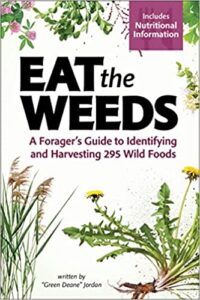
EAT THE WEEDS, the book, 274 plants, 367 pages, index, nutrition charts and color photos. It’s available in many locations including bookstores such as books a million, and Amazon. Most of the entries include a nutritional profile. It can also be ordered through AdventureKeen Publishing. This is weekly newsletter #636. If you want to subscribe to this free newsletter you can find the sign-up form in the menu at the top of the page.
To donate to the Green Deane Newsletter click here.

